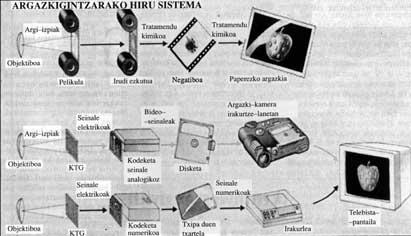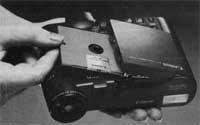Magnetic and silver systems in photography
Today it is possible for a journalist to photograph in a corner of the world (for example in Canada) and watch it on the television screen a minute later in another continent (Europe, Germany, for example). The steps to follow in the process are, in short:
- The camera is placed inside a computer disk (without movies) and just like with any camera photos are taken by pressing the button. (The floppy can take out about 50.)
- From the camera the diskette comes out and the transmitter under the telephone device is accessed.
- By dialing the phone number you call the desired place and there you see photos on the TV that is connected to the phone while talking to the photographer.
The example mentioned is not fiction. This type of camera is for sale in stores. Apparently it is like the rest, with its flash, target, trigger. The only difference (and not the small one) is inside the box. Inside, because the conventional film has been replaced by a magnetic floppy. This type of camera was presented last year by “Canon” at the photography fair in Paris.
Since photography was invented, the silver emulsion film has always been used, and this so-called “magnetic photography” has broken the usual procedure for the first time. The truth is that the first magnetic camera was prepared by the Japanese house “Sony” in 1981, but from then on many other homes (“Nikon”, “Fuji”, “Konica”, etc. ). In this matter a turn is taking place. However, this new system is still complicated and expensive. Therefore, it is mainly used by professionals in the industry, advertising and medicine.
Another option next to the silver film is the electronic camera that has prepared “Fuji”. In this system the camera replaces the film with a chip (integrated circuit). Both in the case of the floppy disk and in the case of the chip, the image is shown on the television screen, in addition to being able to delete both the magnetic and electronic cliché and use it as many times as you want.

Despite all these advantages, “Fuji” and “Canon” ensure that new short-term systems will not rule out the usual. Between 10% and 20% of the market is expected in the coming years. The current price of the camera is about 100,000 pesetas (like a good reflex) and the floppy that occupies 50 photographs is about 1,200 pesetas. In addition, in the new systems the whole process is done by one and it is not necessary to bring the films to reveal outside.
Those interested in selling these new machines also mention the influence of current photographic development laboratories on pollution and the possibility of sending images from anywhere using the phone.
The manufacturers of these new cameras have not yet proposed the paper presentation of magnetic or electronic photographs with special printers (laser, etc.) and while these printers are not prepared, it is necessary to conform to the view of the images on television.
Both magnetic and electronic machines use for imaging an industrially proven technique in the manufacture of a truck for ten years. They use the Charge Coupled Device (CCD). On the surface of the KTG sensor there are hundreds of thousands of photosensitive cells, each of which analyzes a light point (a pixel) of the image. Depending on the light intensity received by each of these elements, they convert the light energy into electric energy. These photosensitive cells, covered by blue, green and red microfilters, which are the three basic colors, are analyzed.
Apart from the objective, KTG is the only content in magnetic and electronic cameras. In the magnetic system the video signals emitted by KTG are encoded analogically (imanizing the metal oxide particles as in the magnetophon in the magnetic support). In the electronic system the signals are digitally encoded, that is, in a binary language that uses 0 and 1 as computers. These two different coding systems make recording/reading systems also different: dynamic in magnetic and static photography in electronic photography.
This difference is very important in practice. The magnetic model ION RC 251 of “Canon” incorporates a floppy spinning mechanism at 3,600 r.p.m. taking the photo. Considering that the floppy has a diameter of 47 mm, the mechanism is a complex miniaturized. The electronic camera with chip does not have this disadvantage, but the most important advantage is to offer photography all the possibilities offered by binary language. The image can be manipulated by computer, for example, exchanging between 0 and 1 in the code, obtaining the negative of the image immediately. Repetition of computer images is also very simple.
The disadvantage of the electronic camera is that it theoretically has the ability to receive image information on the 400,000 octet or byte chip. This figure is almost the same as the capacity of the integrated camera circuit, or that of the computer floppy. For this reason, “Fuji” has at the moment a chip card of only five photographs that will cost about 15,000 pesetas. However, two years ago the Japanese houses “Fuji” and “Toshiba” joined together to develop a system of image compression in chips.
The competition between the magnetic and electronic system will be narrow in the coming years, but the winner will be even narrower with classic film photography. Nowadays, undoubtedly, the photographs revealed on paper predominate, and suffice to say that every year 10,000 tons of silver (40% of total production) are produced in the world for photographic films.
The main advantage of silver film photographs at the moment is image quality. The KTG sensors used in magnetic and electronic photography analyze about 400,000 pixels and in any conventional photo of 24 x 36 mm 20 million points are treated (the house “Kodak” has a film of 90 million points). The figures therefore speak clearly. It should be noted that although KTG sensors have treated many more pixels, the image is seen on the TV screen and the screen has only 450,000 pixels. High definition television (DHTB, which will be broadcast in 1995, will allow to treat 1,500,000 pixels, far from the 20 million points of the traditional photo).

The house “Fuji” says that it has prepared a catcher of 800,000 pixels and that “Kodak” has achieved 1,500,000 pixels. The use of new photopolymers that do not generate diffraction has allowed obtaining cells between five and six times smaller, of approximately one micron. Instead, in the silver film you can get a copy of five hundredths of the micron and also you can get better results. The problem is to increase the sensitivity of the film without the light collectors (the silver crystals on the film surface) getting bigger. It is not advisable to increase the size of the silver crystals, since the definition of the image would be worse. Kodak, for example, wants to achieve the same image quality with a color film with a 6400 ISO sensitivity (16 times higher than normal).
There is another path that has not yet been exploited for agile or high-definition images. It is known that by adding four metal silver atoms a stable and chemically developable metallic grain is achieved. In these conditions, the luminous energy of four photons is sufficient to develop the base grain. However, in very sensitive films, today a 40 photon energy is needed to obtain a grain that can develop. Therefore, the size of the crystals can be ten times smaller.
Silver bromide crystals on the surface of the film are usually not clean. They have impurities and energy performance can be reduced by up to 15%. Even making cleaner silver bromide crystals can improve image quality.
In addition to the purity of crystals, their form becomes important. The use of tubular crystals allows to improve the absorption coefficient of photons, limiting the diffusion of light in the different sensitive layers of the film, being smaller than the classic specimens. In this way lighter colors are obtained.
Currently in films crystals of different shapes are used (cubic, octahedral, tubular, needles, etc.) Manufacturers mix them in certain sizes depending on the characteristics they want to obtain, measuring temperature, pH and bromide concentrations.
To improve image purity, “Fuji” has developed a new system. It incorporates into the slide film the molecule called DIR (Development Inhibitor Releaser) (iodide or derivative). This inhibitor has the ability to choose and attend low-exposure areas and increases the contrast between the light and dark areas of the image.
However, in both silver and magnetic or electronic, in photography there is a strong competition in the search for total perfection.
Buletina
Bidali zure helbide elektronikoa eta jaso asteroko buletina zure sarrera-ontzian











